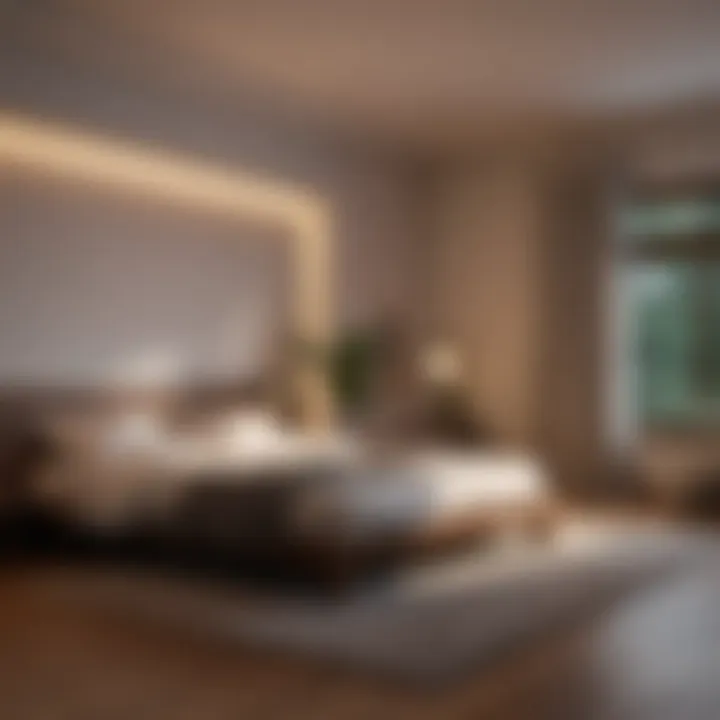Strategies for Enhancing Sleep Quality Effectively


Intro
The quality of sleep plays a crucial role in our mental and physical health. Sleep is not merely a phase of rest; it is a complex biological process that impacts cognitive function, mood regulation, and overall wellness. With increasing demands of daily life, many individuals find themselves struggling to achieve restful sleep. This article aims to provide comprehensive strategies to enhance sleep quality, focusing on practical methods backed by scientific research.
Throughout this article, we will delve into various evidence-based practices, environmental modifications, and dietary considerations that contribute to better sleep. The exploration of mindfulness techniques will introduce tools like guided meditation, which can serve as effective components in an individual's sleep hygiene routine. By understanding and implementing these strategies, readers can personalize their approach to foster improved sleep experiences.
Types of Guided Meditation
Guided meditation is a powerful tool for promoting relaxation and preparing the mind for sleep. There are two primary types that can be particularly beneficial: Mindfulness Meditation and Sleep Meditation.
Mindfulness Meditation
Mindfulness meditation involves focusing on the present moment and becoming aware of thoughts, feelings, and surroundings without judgment. The practice encourages relaxation and can reduce anxiety, which is often a barrier to adequate sleep. Simple techniques such as focusing on one's breath or observing how the body feels can integrate seamlessly into nightly routines.
Sleep Meditation
Sleep meditation is specifically designed to facilitate the transition from wakefulness to sleep. These sessions often include soothing music, guided imagery, or calming narratives that focus on relaxation and letting go of daily stressors. Many people find that engaging in sleep meditation before bedtime leads to a more seamless drift into restful slumber.
The practice of meditation can help in quieting the mind, making it easier to fall asleep and stay asleep throughout the night.
Benefits of Guided Meditation
Incorporating guided meditation into nightly habits can yield several advantages. The benefits extend beyond just improved sleep quality. Here are a few key advantages:
Mental Clarity and Focus
Engaging in meditation regularly has been linked to enhanced mental clarity and improved focus during waking hours. By reducing the noise of daily stressors through mindful practices, individuals may find themselves better equipped to handle tasks and challenges, ultimately supporting better sleep later on.
Improved Sleep Quality
Perhaps the most significant benefit is the pronounced improvement in sleep quality. Guided meditation helps to calm the mind and relax the body, making it conducive for deeper, uninterrupted sleep. Users may notice a reduction in sleep disturbances, leading to a more restorative sleep cycle.
Understanding Sleep Hygiene
Sleep hygiene refers to a constellation of practices and environmental factors that influence the ability to achieve restful sleep. Proper sleep hygiene encompasses behaviors and conditions that facilitate the onset and maintenance of sleep, promoting not just quantity, but quality as well. Understanding sleep hygiene is paramount in this discussion of enhancing sleep quality, as it lays the foundation upon which other strategies can be built.
A clear grasp of sleep hygiene is crucial for all ages interested in improving their mental health. Poor sleep habits can lead to a cascade of physical and mental health issues. Therefore, recognizing and implementing effective sleep hygiene practices can serve as a preventive measure against these issues. The benefits of sound sleep hygiene are numerous. Improved sleep not only leads to increased energy levels and an elevated mood but also supports cognitive function, immune health, and overall well-being.
Defining Sleep Hygiene
Sleep hygiene includes various behavioral and environmental practices that contribute to a better night’s sleep. This can involve specific habits, such as maintaining a regular sleep schedule, creating a bedtime routine, and limiting naps during the day. Key components also include the sleep environment, such as mattress comfort, room temperature, and ambient noise levels. These definitions help to set the stage for more detailed exploration of sleep-enhancing strategies. By adhering to principles of sleep hygiene, individuals may find it easier to fall asleep and stay asleep through the night.
Importance of Sleep Hygiene
The importance of sleep hygiene cannot be overstated. It is the cornerstone of good sleep quality and plays an essential role in one’s health.
- Mental Health: Adequate sleep is critical for emotional regulation and mental clarity, helping combat anxiety and depression.
- Physical Health: Good sleep hygiene has been linked to lower risk for chronic health issues, including heart disease and obesity.
- Productivity: Improved sleep can enhance focus and overall cognitive functioning, leading to better performance in both academic and professional settings.
In essence, prioritizing sleep hygiene is one of the simplest yet most effective strategies for improving sleep quality. It establishes a foundation for further enhancements, making it a crucial component in the journey towards better sleep.
Creating a Sleep-Conducive Environment
Creating a sleep-conducive environment is essential for improving sleep quality. This framework includes ensuring your bedroom is comfortable and free from distractions. Small changes in this space can have a large impact on sleep patterns and overall well-being. A well-designed bedroom may contribute to a smoother transition into sleep, helping the mind and body relax more effectively. Several elements work together harmoniously, enhancing the sleep experience and making it more restorative.
Optimal Bedroom Conditions
Temperature Regulation
Temperature regulation is a critical aspect of creating a comfortable sleep environment. Most people sleep better in a cool room, typically between 60 and 67 degrees Fahrenheit. This specific temperature range is beneficial because it supports the body's natural drop in temperature during sleep. A cooler room can prevent overheating, which often leads to disrupted sleep. Ideally, the bedroom should remain consistently cool, as fluctuations can make it harder to stay asleep.
However, personal preferences do exist. Some individuals may feel more comfortable at slightly warmer temperatures. Therefore, it is critical to find what suits you best. Investing in good insulation, or using fans can maintain stable temperatures, enhancing the sleep experience overall.
Lighting Considerations
Lighting plays a significant role in regulating circadian rhythms. A dark environment signals the brain that it is time to sleep, promoting the production of melatonin. Reducing exposure to natural light in the evening can help prepare the body for rest. Blackout curtains or eye masks are effective options to darken the space overnight.
Artificial lights, especially blue light from electronic devices, can disrupt this process. Limiting screen time and switching to softer, warm lighting in the evening are viable strategies. These minor alterations can greatly improve the chances of achieving restful sleep.
Noise Management
Noise management is essential for uninterrupted sleep. Even low levels of noise can disturb the sleep cycle, leading to insufficient rest. White noise machines or apps can be beneficial, masking sudden sounds that might wake you. Fans or air purifiers can also create a soothing background hum.
Conversely, some people find too quiet a room uncomfortable. Determining your preference is key. Pairing soft sounds with a darkened environment may provide the right setting for deeper sleep.
Choosing the Right Bedding


Mattress Selection
Mattress selection is more crucial than many realize. A supportive mattress can reduce pain and discomfort, allowing for a more restful sleep. Various materials, like memory foam or innerspring, offer unique support levels. Memory foam tends to contour to the body, which can help alleviate pressure points. In contrast, innerspring mattresses provide a bouncier feel, favoring those who prefer a more traditional structure.
It is also important to consider firmness preferences, which vary with body weight and sleeping position. Testing different mattresses can reveal what feels best to you. Ultimately, a good mattress leads to better sleep quality, making it a worthy investment.
Pillow Types
Pillow types contribute significantly to sleep quality as well. A well-chosen pillow supports the neck in alignment with the spine. This is essential for preventing discomfort during the night. Various materials, such as memory foam and down, provide distinct support levels.
Sleeping position can guide pillow choice; stomach sleepers may prefer softer, thinner options, while back and side sleepers usually benefit from firmer, thicker pillows. Selecting the right pillow can relieve tension in the neck and shoulders, enhancing overall comfort.
Bedding Fabrics
Bedding fabrics can influence sleep comfort. Materials like cotton and linen are breathable and help regulate temperature well. They wick moisture away from the skin, preventing overheating. On the other hand, synthetic fabrics may retain heat, which could be less favorable for sleep.
Also, consider the weave of the fabric. Percale offers a crisp feel, while sateen provides a softer, smoother texture. The right bedding can create a comfortable atmosphere that complements sleep hygiene effectively.
Establishing a Consistent Sleep Routine
A consistent sleep routine is crucial for improving overall sleep quality. It establishes a rhythm that your body can recognize, promoting more restful sleep patterns. Sleep routines help regulate the body's internal clock, often referred to as the circadian rhythm. When this rhythm is maintained, it can lead to quicker sleep onset and deeper sleep phases. Enhancing sleep quality through a routine also brings other benefits. People who follow consistent sleep habits often report improved alertness and mental clarity during the day.
Importance of Consistency
Consistency in sleep patterns cannot be overstated. Regular sleep and wake times establish a predictable cycle. This predictability helps the body understand when it is time to sleep and when it is time to be awake. Inconsistent sleep cycles can disrupt this process, leading to sleep disorders such as insomnia or hypersomnia. When an individual does not adhere to a regular schedule, they can experience difficulty falling asleep, waking up too early, and suffering from daytime fatigue. Thus, dedicating time to create consistency is an essential step in promoting quality sleep.
Strategies for Setting a Sleep Schedule
Bedtime Rituals
Bedtime rituals involve a series of activities performed in preparation for sleep. These rituals can include reading a book, taking a warm bath, or practicing relaxation techniques. The key characteristic of bedtime rituals is their role in signaling to the body that it is time to wind down for the night. By engaging in calming activities before bed, people can enhance the transition from wakefulness to sleep. This makes bedtime rituals a popular choice for those looking to improve sleep hygiene.
A unique feature of bedtime rituals is their adaptability. Individuals can tailor them to their preferences, whether they involve calming music, meditation, or light stretching. However, there can be drawbacks. If rituals are too stimulating or lengthy, they might delay sleep onset rather than promote it. Therefore, simplicity and consistency are vital in maintaining effective rituals.
Wake Up Techniques
Wake up techniques focus on how individuals transition from sleep to waking. The key characteristic of effective wake-up techniques is their ability to promote alertness upon rising. Using alarms, choosing a gradual light alarm, or incorporating gentle stretches can help improve this process. These methods are beneficial choices in establishing a consistent sleep routine, as they create a positive start to the day and reinforce the body's natural wake-up signals.
A distinctive advantage of wake-up techniques is their timing flexibility. Employing methods that rely on natural light or soft sounds can make waking up less jarring. However, reliance on loud alarms can lead to stress and a sense of disorientation upon waking. This could negatively impact the overall quality of sleep.
Establishing a consistent sleep routine reinforces the body’s natural cycles, improving overall sleep quality and daytime function.
Relaxation Techniques for Better Sleep
Relaxation techniques are essential in enhancing sleep quality. These methods help to calm the mind and body, preparing them for the restful state needed for good sleep. Stress and anxiety can hinder sleep by creating restless nights and continuous worrying. By incorporating relaxation practices into your routine, you can soothe these feelings. This section covers various techniques, their effectiveness, and how they can be integrated into your nightly schedule.
Effective relaxation techniques are proven to improve sleep onset and quality, making them an invaluable part of a sleep enhancement strategy.
Breathing Exercises
Breathing exercises are simple but effective ways to relieve stress. They involve focusing on your breath to bring attention away from anxiety-inducing thoughts. Common techniques include deep abdominal breathing and the 4-7-8 method.
The deep abdominal method involves inhaling through the nose for a count of four, holding for seven, and then exhaling through the mouth for a count of eight. This technique slows down your heart rate and induces a sense of calm.
Incorporating these exercises into your pre-sleep routine can significantly lower tension and prepare your body for sleep. Allocate a few minutes each night to practice this technique. Those who commit to a regular breathing routine often experience fewer sleep disturbances.
Progressive Muscle Relaxation
Progressive muscle relaxation (PMR) focuses on tensing and relaxing muscle groups throughout the body. This technique can help release built-up tension. Start with the feet, squeezing the muscles tightly for five seconds before releasing and moving up through the body. Each muscle group is paired with deliberate breathing, enhancing the relaxation experience.
The benefits of PMR include reducing anxiety and promoting overall wellbeing. It allows individuals to become more aware of where they hold tension and helps them practice releasing it. This awareness helps build a personal relationship with one’s body, leading to better stress management. Try incorporating PMR into your bedtime routine or during moments of high stress during the day.
Guided Visualization
Guided visualization is an imaginative technique where one visualizes calming scenes, helping redirect focus from stressors. This can be led by a recorded voice or through self-guided imagery. Picture serene settings, such as beaches or forests, to foster a peaceful mindset.
Widely used in various therapeutic practices, guided visualization can produce significant wellness benefits. It can decrease anxiety and foster tranquility as one drifts into sleep. To implement this technique, dedicate a few minutes each evening to explore calming imagery or listen to a guided session. Over time, it can be a powerful tool in promoting a restful night's sleep.
Dietary Influences on Sleep
Sleep quality is significantly influenced by dietary choices. What you consume can affect not only your ability to fall asleep but also the overall quality of rest you experience. A balanced diet contributes to physical health, which in turn supports better sleep patterns. Nutrients and substances found in common foods can either promote restful sleep or disrupt it. Understanding these elements allows individuals to make informed dietary choices that foster healthier sleep habits.
Foods that Promote Sleep
Certain foods are known to enhance sleep quality due to their composition. For example, foods rich in tryptophan, an amino acid that converts into serotonin and subsequently melatonin, are beneficial. Common sources include turkey, dairy, and nuts. Incorporating these foods into your evening meal can promote restful sleep.
Here are additional food categories that may contribute to better sleep:


- Complex Carbohydrates: Foods like whole grains and oats can help increase the availability of tryptophan.
- Fruit and Vegetables: Cherries and bananas are excellent examples; both have properties that promote sleep. Cherries, in particular, are one of the few natural sources of melatonin.
- Fatty Fish: Salmon and mackerel contain omega-3 fatty acids and vitamin D, both crucial for sleep regulation and mood.
In summary, a thoughtful approach to diet, focusing on specific foods that enhance sleep, can serve as a valuable strategy when seeking to improve rest quality.
Caffeine and Alcohol Considerations
Caffeine and alcohol play prominent roles in sleep quality and should be consumed with caution. Caffeine, a stimulant found in coffee, tea, chocolate, and some energy drinks, can disrupt sleep patterns. Even when consumed several hours before bedtime, it can hinder the ability to fall asleep and reduce overall sleep duration.
On the other hand, while alcohol may initially induce sleepiness, it lingers in the system and can impact the sleep cycle. The quality of sleep tends to worsen as the metabolites of alcohol begin affecting the body. It can reduce the time spent in restorative stages of sleep, leading to a less refreshing rest.
"What you eat, and when you eat it, significantly affects your capacity for restorative sleep." source
Maintaining a focus on dietary influences can empower individuals seeking effective strategies to enhance their sleep quality.
Mindfulness and Meditation Practices
Mindfulness and meditation are essential to enhancing sleep quality. These practices focus on increasing awareness and promoting a sense of calmness, which can be instrumental for individuals experiencing difficulty in falling asleep or staying asleep. Sleep quality is often disrupted by racing thoughts, stress, and anxiety, all of which can be alleviated through mindfulness and meditation techniques. By cultivating a routine centered on relaxation and present-moment awareness, individuals can create a more conducive environment for restful sleep.
Meditation Techniques for Sleep
Meditation offers various techniques that can significantly enhance an individual’s ability to unwind at the end of the day. Some common methods include:
- Guided Meditation: This involves listening to a recording that leads individuals through a calming narrative. It helps direct focus away from stressors and encourages relaxation.
- Body Scan: This technique requires focusing attention on different parts of the body, promoting awareness and relaxation in each area. This method is particularly effective for recognizing areas of tension and consciously relaxing them.
- Mindfulness Meditation: By focusing on the breath and observing thoughts without judgment, this practice encourages a tranquil mindset. It helps individuals detach from intrusive thoughts that may hinder sleep.
Engaging in these techniques for a few minutes each night can significantly prepare the mind and body for sleep.
Mindfulness in Daily Life
Incorporating mindfulness into daily routines can create a lasting impact on sleep quality. Practicing mindfulness involves being fully present in the moment, which can reduce stress levels throughout the day. Here are ways to apply mindfulness:
- Mindful Eating: Paying attention to the flavors and textures of food can promote a more relaxed state and assist in digestion, further aiding sleep.
- Mindful Walking: Taking a moment to observe the surroundings while walking can ground individuals, reducing anxiety and promoting a feeling of peace.
- Breathing Exercises: Regularly engaging in deep breathing exercises increases oxygen supply to the brain, encourages relaxation, and can serve as a preparatory step to sleep.
“Practicing mindfulness daily lays the foundation for calming the mind at night.”
By actively engaging in mindfulness, individuals can establish a routine that not only enhances mental health but also improves overall sleep hygiene. It encourages a state of relaxation that diminishes anxiety, leading to better sleep quality.
Managing Stress and Anxiety
Managing stress and anxiety is crucial for achieving better sleep quality. High levels of stress and unresolved anxiety can lead to insomnia and disrupt sleep cycles. Addressing these issues enhances overall wellbeing and promotes restful sleep. When the body is tense and the mind is racing, falling asleep becomes a challenge. Reducing stress improves mental health, which, in turn, supports a healthier sleep environment.
Identifying Stressors
Identifying stressors is the first step in managing stress and anxiety. Stressors differ from one person to another. Common stressors can include work pressures, family responsibilities, or health concerns. Acknowledging these triggers increases awareness and allows for better management. Keeping a stress journal can help identify patterns and significant stressors in daily life. Recognizing specific stressors can lead to actionable steps to reduce their impact, creating a more peaceful mental space conducive to sleep.
Coping Mechanisms
Coping mechanisms are strategies to deal with stress and anxiety. They can be broadly categorized into two main approaches: active coping and avoidance coping. Active coping involves confronting problems head-on, while avoidance coping entails evading stressors. A balanced approach is often more effective.
Cognitive Behavioral Techniques
Cognitive Behavioral Techniques (CBT) focus on changing negative thought patterns. This approach helps individuals replace harmful thoughts with more constructive ones. CBT has gained recognition for its effectiveness in reducing anxiety and stress. One key characteristic of CBT is its structured format, which provides a systematic way to address anxious thoughts. This technique is popular due to its flexibility; it can be adapted to various situations and has a strong evidence base supporting its efficacy.
The unique feature of CBT is its focus on actionable steps. Individuals learn to challenge their negative beliefs and replace them with more realistic ones. Advantages include improved coping skills and better regulation of emotions. However, some may find the cognitive restructuring process challenging at first.
Journaling
Journaling is another impactful coping mechanism. This technique offers a safe space to express thoughts and emotions. Writing about stressors can provide clarity and diminish anxiety levels. The key characteristic of journaling is its accessibility; anyone can start at any time. It is a beneficial choice for this topic.
By reflecting on daily events and emotions, individuals gain insights into their stressors over time. The unique feature of journaling lies in its ability to serve as an emotional release. It encourages self-reflection and problem-solving. Advantages include enhanced self-awareness and reduced anxiety.
"Writing is a way of talking without being interrupted."
However, some may find it difficult to put feelings into words initially. It can also take time to notice the benefits, which may deter some. Patience is key to integrating journaling as a coping mechanism.
Overall, both Cognitive Behavioral Techniques and journaling serve as powerful tools against stress and anxiety. By managing these factors effectively, individuals can pave the way for better sleep quality and improved mental well-being.
Limiting Screen Time Before Bed
Limiting screen time before bed is crucial for enhancing sleep quality. Modern lifestyles heavily involve screens, whether from smartphones, tablets, computers, or televisions. The impact of this screen time extends into the night, often disrupting the natural sleep cycle. Understanding the importance of reducing screen exposure can help individuals cultivate healthier bedtime habits.
Screen time engages both visual and cognitive faculties, making it harder for the brain to wind down. Blue light emitted from screens especially plays a significant role in sleep disruption. Reducing screen time allows for a more relaxed transition into sleep, which is essential in obtaining restorative rest.
Effects of Blue Light on Sleep
Blue light significantly influences sleep patterns. This type of light, found predominantly in digital screens, interferes with the production of melatonin, the hormone responsible for regulating sleep. An increase in blue light exposure in the evening can lead to increased alertness and difficulty falling asleep. Research indicates that individuals who reduce blue light exposure in the hours before bedtime often experience better sleep quality.
Some key effects of blue light include:


- Disruption of Circadian Rhythms: Blue light affects the body's internal clock, making it challenging to establish a regular sleep-wake cycle.
- Delayed Sleep Onset: Extended screen usage can result in taking longer to fall asleep, contributing to insufficient rest.
- Reduced Sleep Duration: Oversaturation of evening screen exposure can shorten overall sleep duration, impairing cognitive function and mood the following day.
Addressing blue light's impact can lead to significant improvements in sleep quality for many individuals.
Alternatives to Screen Use
Finding alternatives to screen usage before bedtime can greatly improve sleep quality. There are various activities that can effectively replace screen time without compromising relaxation or engagement.
Some alternatives include:
- Reading Physical Books: Engaging with a book can be calming and can absorb attention without the negative effects of blue light.
- Listening to Music or Podcasts: Soft music or calming podcasts can aid relaxation and prepare the mind for sleep.
- Meditation and Relaxation Techniques: Using guided meditations or soothing exercises can promote mental clarity while directing focus away from screens.
- Journaling: Putting thoughts on paper before bedtime can help clear the mind and alleviate stress, facilitating a better sleep transition.
Choosing these alternatives shows a commitment to enhancing one’s sleep hygiene.
By limiting screen time before bed and exploring alternate activities, individuals can bring about notable improvements in their sleep patterns, leading to enhanced mental and physical health.
Physical Activity and Sleep Quality
Physical activity plays a significant role in the overall quality of sleep and is an essential element in enhancing sleep experiences. Engaging in regular exercise has been shown to reduce symptoms of insomnia, improve sleep duration, and promote deeper sleep stages. The relationship between physical activity and sleep quality is multifaceted, influenced by various factors such as timing, type of exercise, and individual lifestyle preferences. Understanding how to incorporate exercise into one’s routine effectively can lead to tangible improvements in sleep.
Benefits of Exercise on Sleep
- Reduces Anxiety and Stress: Physical activity triggers the release of endorphins, which can alleviate feelings of anxiety and stress, common barriers to quality sleep.
- Regulates Sleep Patterns: Regular exercise can help normalize circadian rhythms, making it easier to fall asleep and wake up at desired times.
- Enhances Sleep Quality: Research indicates that those who regularly exercise tend to experience longer periods of restorative sleep. This can lead to improved overall health and well-being.
Additionally, exercise can serve as a natural remedy for sleep-related disorders. Individuals suffering from sleep-related conditions often find that a consistent exercise regimen helps in managing their symptoms more effectively.
Optimal Timing for Exercise
The timing of physical activity is crucial in maximizing its benefits for sleep. For many, exercising in the morning or early afternoon is regarded as the most beneficial approach. This schedule promotes energy levels throughout the day and often leads to better sleep quality at night.
However, it is important to note that late-night workouts can have varying effects on individuals. Some might find that exercising too close to bedtime can interfere with their ability to wind down, thus hindering their sleep onset. Understanding your body’s responses to different exercise times can help establish a routine that best supports your sleep needs.
"Exercise is a powerful sleep aid, yet timing and personal response are vital to harnessing its full potential."
Considerations for Timing
- Avoid intense workouts close to bedtime: Aim to finish vigorous exercise sessions at least two to three hours before sleep.
- Listen to your body: Pay attention to how different times of day affect your sleep, and adjust your routine accordingly.
Types of Exercise Beneficial for Sleep
Not all exercises have the same impact on sleep quality. Certain types of physical activities are particularly effective in promoting restful sleep.
1. Aerobic Exercises:
- Running, cycling, and swimming are great examples. These activities elevate heart rate and improve cardiovascular health, leading to enhanced sleep quality.
2. Strength Training:
- Engaging in weight lifting or resistance exercises can also contribute positively to sleep. Strength training boosts muscle mass, which may enhance metabolism and sleep efficiency.
3. Relaxation Techniques:
- Practices such as yoga and tai chi not only improve flexibility and strength but also emphasize relaxation. They can significantly lower stress levels and prepare the mind for sleep.
Incorporating a blend of these exercise types into your weekly routine can yield beneficial outcomes for sleep quality. A well-rounded fitness plan that balances intensity with relaxation helps pave the way for both physical health and restorative sleep.
When to Seek Professional Help
In the quest for improved sleep quality, many individuals may find themselves encountering persistent challenges that self-help strategies cannot adequately address. Recognizing when to seek professional help is crucial in navigating these difficulties. It is essential to understand that not all sleep issues can be resolved through lifestyle changes alone.
Several factors indicate it might be time to consult a healthcare provider. If sleep disturbances start to significantly impact daily functioning, such as during work or engaging in social activities, this is a sign that intervention may be necessary. Chronic symptoms like insomnia, sleep apnea, or restless leg syndrome require a thorough assessment. Professional help can provide targeted solutions that enhance sleep hygiene more effectively than general remedies.
In addition, seeking help from a specialist can assist in identifying underlying conditions affecting sleep. Mental health issues, such as anxiety and depression, often manifest through disrupted sleep patterns. Addressing these overarching problems alongside sleep treatment can lead to a more comprehensive recovery.
Seeking professional assistance can help diagnose sleep disorders that may not be apparent and establish a tailored plan for improvement.
Recognizing Sleep Disorders
Being able to recognize sleep disorders is the first step toward seeking professional help. Some common disorders include:
- Insomnia: A condition characterized by difficulty falling or staying asleep.
- Sleep Apnea: A serious disorder where breathing repeatedly stops and starts during sleep.
- Restless Leg Syndrome: A condition that causes an uncontrollable urge to move one's legs, often disrupting sleep.
- Narcolepsy: A neurological disorder affecting the control of sleep and wakefulness.
Individuals should monitor how often they experience symptoms such as excessive daytime sleepiness, snoring, or difficulty concentrating. Keeping a sleep diary can assist in tracking patterns over time and facilitate discussions with health professionals.
Consultation and Assessment
Once a sleep disorder is suspected, the next step involves consultation and evaluation with a healthcare professional. During this process, individuals will typically undergo a detailed assessment that may include:
- Medical history: Providing insight into past health concerns and lifestyle habits.
- Physical examination: Assessing overall health and identifying potential underlying issues.
- Sleep study: Conducted either at home or in a sleep clinic, this can monitor various parameters during sleep.
The evaluation's outcomes will help in formulating a personalized treatment plan. This may involve medication, therapy, or various behavioral interventions tailored to the specific type of sleep disorder identified.
In summary, understanding when to seek professional help regarding sleep challenges is vital. Recognizing the signs of sleep disorders and taking the initiative to consult a healthcare provider can pave the way for effective solutions, leading to improved sleep quality and overall well-being.







